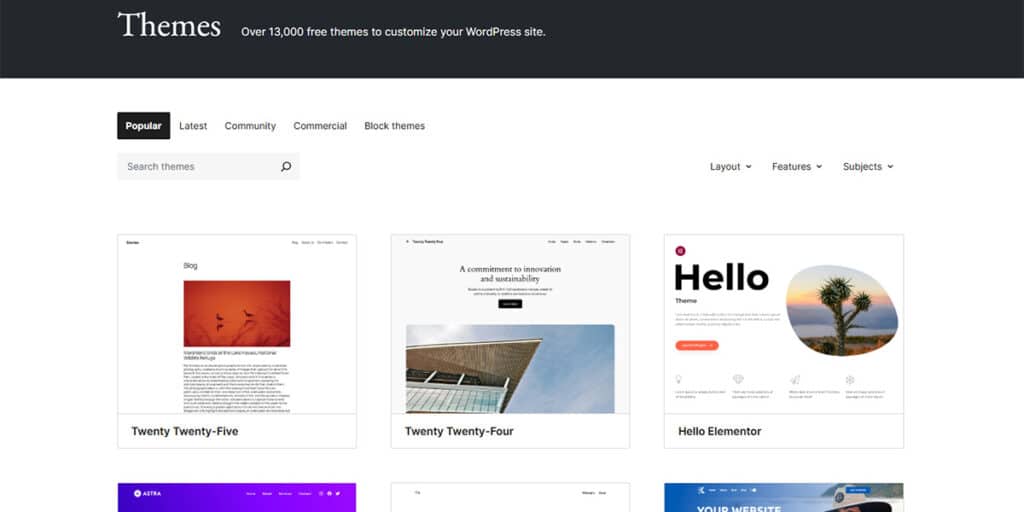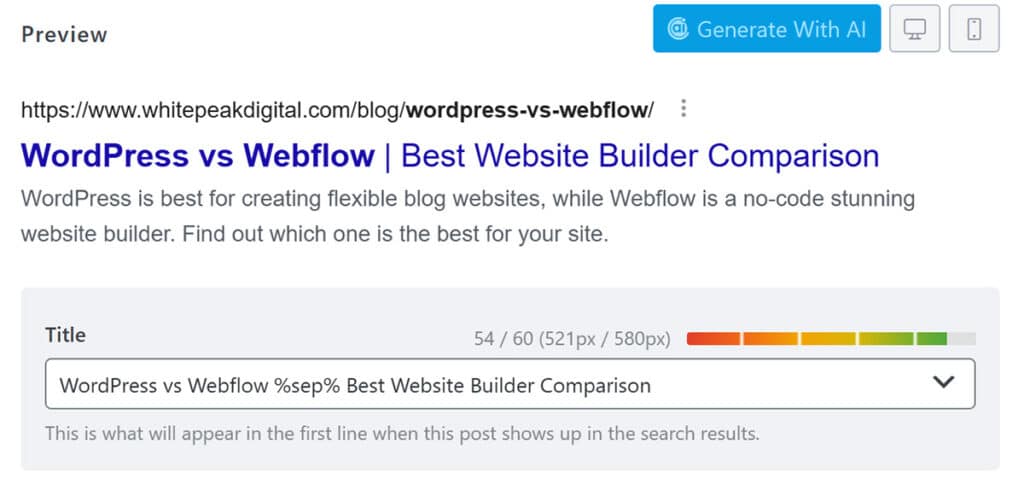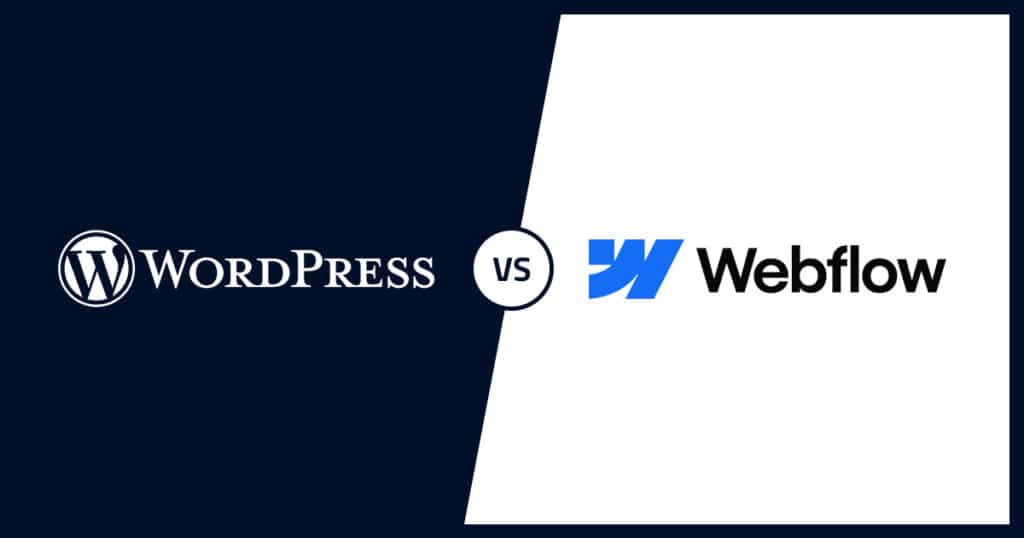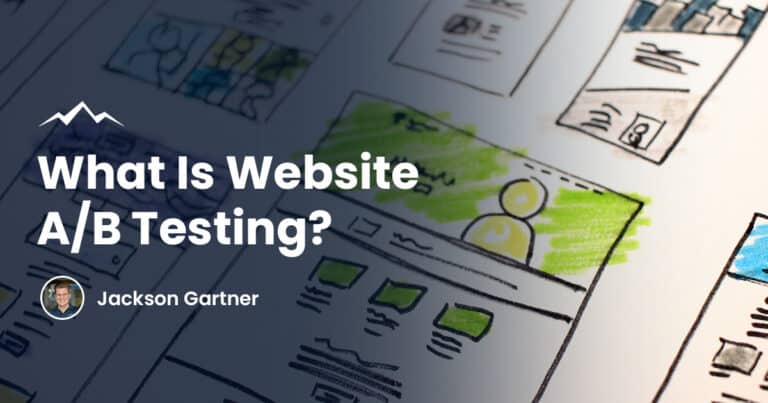Deciding on which platform to choose when building a new website can be challenging as both Webflow and WordPress are leading platforms in the industry.
WordPress and Webflow are two of the most popular content management systems (CMS) that are widely used for building websites.
A Forrester Wave report for content management systems highlights both WordPress and Webflow as the ‘Strong Performers’ in Q1 2025. However, they take their own unique approaches to creating websites.
WordPress can help you to build engaging blogs and exceptionally user-friendly websites. It is renowned for its unlimited plugins, easy customisations and scalability.
Conversely, Webflow is known for its simple drag-and-drop functionality through which you can design creative and visually-appealing websites without writing a single line of code.
Although both CMS platforms have a devoted user base, deciding which is perfect for you requires a detailed head-to-head comparison of their expansive features.
What Is WordPress?
Launched in 2003, WordPress.org is a premier open-source website-building platform, accounting for 61.4% of all websites that use a CMS.
Open-source means that the source code of the WordPress CMS is accessible for free to anyone from beginners to skilled developers.
However, users need to pay for upfront costs such as website hosting, a domain name and paid plugins.
Starting as a simple blogging platform, WordPress has now developed into a comprehensive CMS that can manage any kind of content, including websites, portfolios, eCommerce stores and enterprise websites.
Its open-source approach allows for an extensive level of customisation, through thousands of themes and plugins, providing nearly unlimited design possibilities.
Although there is a learning curve for advanced customisation, you can leverage the platform’s full potential using technical expertise or WordPress development support.
Difference Between WordPress.org and WordPress.com
WordPress.org is a self-hosted and free platform that offers complete control over your website, whereas WordPress.com is a paid service platform with limited flexibility.
Most people and also here in this article, when talking about ‘WordPress’, refer to the self-hosted version on WordPress.org.
Pro tip: You can find out more about the differences between WordPress.org and WordPress.com in this article.
What Is Webflow?
Webflow is an advanced CMS for building and hosting websites introduced in 2013. It has a current market share of 1.2% among the top content management systems.
It is a closed-source platform, which means the source code isn’t available to the general public. Rather, it is based on the paid license-tiered subscription model to gain access.
The visual website builder and exceptionally intuitive drag-and-drop editing interface in Webflow allow designers and web design agencies to create amazing, customised websites without any need for coding.
This enhances users’ ability to create custom and unique websites from scratch without any dependence on a Webflow developer.

WordPress vs Webflow: Head-to-Head
Let’s now compare the core features of WordPress and Webflow and see which one is the best for your next website.
This will help you decide which CMS platform can deliver improved performance, scalability and functionality for your website requirements.
Ease of Use
Being a typical CMS, WordPress might be a little overwhelming for new users because of its steep learning curve to find the right domain name, hosting server and manage themes/plugins.
But once everything is sorted, WordPress is a great platform in comparison to other WordPress alternatives for building any website from basic web pages to sophisticated business websites.
On the contrary, Webflow is quite easy to use, particularly for users with no basic knowledge of coding language.
The design editor offers more user-friendly and innovative website design options as compared to the basic editor of WordPress.
Webflow also requires a slight learning curve for advanced interactions and animations, but it provides complete assistance and resources to help users.
The Verdict
Of the two, Webflow is much easier to use out of the box for new users and beginners because of its design freedom and no-code platform that’s ready to go after creating an account.
However, if you are a professional with a bit of technical knowledge of coding essentials, then WordPress can be a good choice to build websites using advanced plugins and customisations.
Themes & Templates
WordPress offers 13,000 free themes in addition to paid options. A theme manages the overall design and layout of the website but can vary in complexity and features significantly based on the theme you choose.
A WordPress website can utilise only one theme at a time, which can be accessed through the WordPress Theme Directory or can be purchased through third-party marketplaces.

Pre-built WordPress templates can often come with a theme which provide pre-built pages or sections that you can use for your website. You can use as many templates as you want that come with the chosen theme.
Compared to WordPress, Webflow offers fewer templates at around 7,000 free and paid options that encourage customers to customise further without the need for professional assistance.
Webflow also offers free and paid templates to provide users with more options to choose from premium designs.
Another important difference between the website builders is that updating a theme in WordPress is far simpler than updating a template in Webflow.
If you wish to work with a different template, you need to start over with a new project and then select the desired template.
The Verdict
It is quite clear that WordPress is the clear winner with thousands of free and paid theme options and easy template updates as compared to Webflow.
Pricing
WordPress is known for being open-source, which makes the base platform free to use. However, it incurs additional costs for hosting and paid plugins or themes.
WordPress does allow users to choose their own cost-effective hosting options, thereby making it suitable for a variety of budgets.
Pro tip: Find the best WordPress hosting for your site in this other article of ours.
Webflow has a subscription-based pricing structure and provides a range of plans to meet the requirements of users from start-ups to large international companies.
Additionally, the price also depends on whether you are using Webflow for an eCommerce store or just a standard website.
Although Webflow’s plan covers hosting, SSL and other essentials, the platform may become pricey for websites requiring more features, traffic and content.

The Verdict
WordPress is more cost-effective as it can be as comprehensive or economical as you wish. However, with Webflow, customers may only access specific functions after paying a particular subscription.
Plugins & Extensions
WordPress is known for its extensive library of plugins and extensions.
From SEO to eCommerce and contact forms, users can add nearly any feature to their website with the help of more than 59,000 free plugins and thousands of paid alternatives.
Unlike WordPress, Webflow does not offer official plugins, therefore users cannot add extensions that directly function with the Webflow interface. You can add your own custom code to further enhance your pages however.
The Verdict
WordPress plugins are completely integrated into the platform, making them easier to use without additional configuration. This makes WordPress the clear winner for plugin and feature flexibility.
Search Engine Optimisation (SEO)
WordPress offers a few built-in SEO capabilities, that allow users to establish simple URLs, adjust permalink options, add tags to blog articles and guarantee your website is search engine compatible.
WordPress also has free SEO plugins such as Yoast SEO or RankMath that enable users to effortlessly manage sitemaps, meta tags and other essential components.

By using WordPress plugins, you can manage your social networks, integrate Google Search Console and Google Analytics and quickly suggest breadcrumbs to assist users in navigating to your website.
Webflow also provides integrated SEO features that help manage key SEO components without the need for third-party plugins. Allowing you to easily change page title tags, meta descriptions and URLs.
Additionally, you can modify the open graph parameters for social media optimisation and verify how your content appears on social platforms.
You can also create automatic sitemaps, but you need to purchase a subscription beforehand.
The Verdict
WordPress provides greater capabilities and versatility for search engine optimisation.
Using a recommended SEO plugin, you can do almost everything necessary to improve SEO rankings. Unlike this, Webflow’s integrated tools provide relatively limited options.
Website Building Tools
WordPress provides a large selection of building tools for creating web pages or complete websites.
Its block editor Gutenberg offers an easy drag-and-drop interface and third-party website builders such as Elementor allow users to create highly customisable layouts using pre-designed elements and templates.
Webflow’s building tools consist of an intuitive drag-and-drop interface that helps in creating and modifying web page layouts, pictures and fonts.
Compared to Webflow alternatives, its CMS is much easier to use as it provides dynamic themes and templates that are seamlessly integrated with the designer.
The hosting tools provide reliability with secure architecture, built-in SSL certificates, an extensive content delivery network (CDN), an improved website load speed and automated backups.
Webflow’s interactive tools also enhance website engagement by allowing users to create animations, transitions and hover effects in a zero-coding environment.
The Verdict
Webflow offers user flexibility with no coding requirements in their website building platform.
Its design-centric approach, built-in hosting and performance optimisation make it a better option for beginners when compared to WordPress.

Mobile Optimisation
WordPress uses responsive themes and plugins like AMP which automatically adjust the layout of the web pages according to the screen size of mobile devices.
It also allows users to manually adjust and edit the controls for screen adjustments or responses to enhance usability.
Nevertheless, WordPress’s mobile optimisation can require the use of external plugins, third-party tools and custom coding which does make it partially dependent on external solutions.
On the other hand, Webflow’s designer tool allows users to modify the layouts of websites for various screen sizes with real-time previews.
Webflow automatically generates lightweight and simple code that can be downloaded by mobile devices extremely quickly.
It also offers automated features for image optimisation, improved touch-friendly interfaces and grid systems for effective performance.
The Verdict
Overall, Webflow offers more streamlined, user-friendly, fast and innovative capabilities for website mobile optimisation.
Website Security
WordPress offers basic security features, but fails to incorporate two-factor authentication without a third-party plugin, which increases its vulnerability.
Users need to depend on security plugins such as Wordfence or AIOS to enhance security and prevent infiltration.
Although it supports HTTPS redirection and SSL encryption, these features are typically managed by plugins and hosting services.
Webflow’s security is based on a shared responsibility model that is largely built on AWS (Amazon Web Services).
Additionally, they have deployed several encryption techniques to safeguard user data, payment process and other critical aspects.
Webflow also offers built-in data backup tools to restore data in case of any loss of data or information.
The Verdict
With its advanced encryption tools and integration with AWS, Webflow clearly does better out of the box to ensure website privacy and security in comparison to WordPress.
Customisation & Design Flexibility
WordPress’s customisation and design flexibility are almost limitless.
It provides its users complete authority over website design, functionality and content by allowing them to customise websites through 50,000+ free plugins and themes.

Users with technical expertise can extensively customise WordPress by modifying existing themes through custom code as well.
On the other hand, Webflow gives you control with design flexibility but with limited customisation options.
It gives you control of 20+ design elements, such as colour palettes, typography and layouts, that you can change to customise your website.
It is best suited for projects that do not require complex customisations as Webflow does not support plugins like WordPress.
The Verdict
WordPress is a clear winner with unparalleled and vast customisation options as compared to Webflow.
Blogging
WordPress was initially designed as a blogging platform and later on upgraded to a powerful CMS. Its content management capabilities are straightforward and effective.
To use WordPress for a blog, users rely on the Gutenberg editor. It allows them to create high-performing blog posts through blocks that include texts and media.
As opposed to this, Webflow is less adaptable when it comes to blogging. Its editor requires advanced features as the existing ones restrict the amount of CMS and additional edits.
For example, it lacks a comment area, does not support text wrapping or word breaking, and the content cannot be tagged or categorised in the same way as in WordPress.
The Verdict
Inherently a blogging platform, WordPress is a better option for blogging as it provides an endless number of CMS elements and editors.
eCommerce
WordPress lacks inbuilt eCommerce capabilities but supports the installation of free plugins to create an online eCommerce store.
WooCommerce is the most popular WordPress plugin that can be utilised to develop eCommerce platforms. However, several features require paid extensions leading to an increase in expenses and complexity in maintenance.

With its integrated eCommerce features, Webflow is an easy option for small business web design.
The platform lets users utilise the same design applications that are implemented for the rest of the website to create product pages, payment gateways and emails to customers.
However, it lacks complex features such as third-party app integrations, multi-currency support and advanced logistics options offered on other platforms.
The Verdict
Depending upon the business requirements, WordPress and WooCommerce is a favourite among large eCommerce stores because of its high customisability. Webflow is useful for simpler and smaller stores because of its ease of use.
Pro tip: If you’re looking to build an eCommerce online store exclusively, our team would recommend taking a look at the Shopify platform.
Support
WordPress being a free and open-source platform means there are no official customer support channels. However, you can use their community forums and resources to find answers to your problems.
You can also refer to the documentation pages and WordPress learning platform where you may get user-friendly and technical solutions.
Webflow provides several types of support options, such as a knowledge library with comprehensive articles, Webflow university with video lectures and a community forum for open discussions.
Users can also gain immediate access to Webflow’s support team through emails, available from Monday to Friday with a response time of 48 hours.
The Verdict
Both WordPress and Webflow offer several options to seek support. Given the popularity and global fanbase of WordPress, the resources and community support make it a leader in this category.
However, having dedicated customer support is also a big advantage for Webflow.
WordPress & Webflow Comparison
Now that we have discussed the capabilities of both platforms, let’s explore their advantages and disadvantages to further assist your decision-making:
Comparison of Advantages
| Feature | WordPress | Webflow |
| Cost | Open-source, free to use (except domain and paid customisations) | Subscription-based model, built-in hosting |
| Ease Of Use | Easy navigation with smart dashboards. | Robust visual editor, no coding required. |
| Customisations | Thousands of free and paid plugin and themes | No need for plugins, built in platform |
| Support & Community | Global popularity with vast learning resources | Direct customer support via email |
| SEO & Optimisation | Built-in SEO features and plugins | Superior integrated performance optimisation |
Comparison of Disadvantages
| Feature | WordPress | Webflow |
| Customisation | Complex customisations may require coding experience | Closed architecture makes third-party customisations difficult. |
| Maintenance & Updates | Users are responsible for maintaining and updating WordPress | Requires a monthly subscription, making it expensive than WordPress |
| Plugins & Extensions | Large dependency on plugins, increasing platform complexity | Do not have a large plugin store like WordPress |
| Support & Community | No direct customer support from the platform | Less community support and a smaller knowledge base |
| Performance | Needs improvement in terms of security | Lacks advanced eCommerce SEO services |
Final Recommendation
Despite their differences, WordPress and Webflow are equally excellent tools for building websites. However, which platform to choose depends largely on your project requirements.
Use WordPress if you desire a proven platform with strong capabilities, improved scalability, rich plugins and community assistance. It is also an affordable way to get started with a website that offers great flexibility.
But if you are looking for an easy way to set up a website quickly without coding, then use Webflow. It is perfect for designers, SMEs and anyone who wishes to design an easy-to-use and good-looking website with minimal effort.
Frequently Asked Questions
Which platform should a new user choose between WordPress and Webflow?
New users should consider Webflow for its simple setup process and intuitive drag-and-drop interface. WordPress provides more customisation possibilities and greater flexibility, although it requires users to learn through a steeper learning curve.
Is Webflow or WordPress better suited for blogging?
WordPress stands out as the top choice for blogging because it offers excellent content management tools alongside great customisation possibilities and exceptional SEO features.
Is Webflow more expensive than WordPress?
Webflow costs more because of its premium features and subscription options, while WordPress remains free and open-source unless you factor in domain costs and plugin purchases.
Can I migrate from WordPress to Webflow or vice versa?
Yes, you can migrate between WordPress and Webflow but whether this is feasible depends entirely on the complexity of your website. You can rely on tools and strategies from both platforms to achieve successful website migrations.
Is WordPress or Webflow the best website builder?
WordPress is a better option if you prefer scalability and customisation via plugins and themes, while Webflow is a good option if you prioritise ease of use, security and improved visual appeal of your website.





